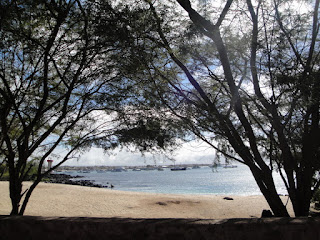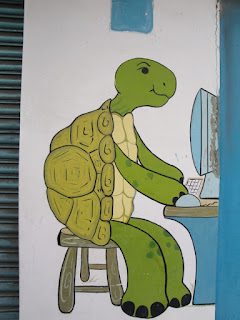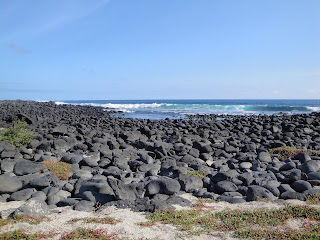San Cristobal Island is one of the Galapagos Islands and its main town, Puerto Baquerizo Moreno, is the capital of all the islands. The island is connected to Quito and Guayaquil by air and to some of the other islands by boat. Some cruises start from here. It has a population of about 6,000 and most of the adult males are fishermen.
Total Pageviews
Wednesday, September 29, 2010
Main Tourist Sites
Cerro Brujo
Cerro Brujo is one of the nicest beaches in the northeast end of the island. It has sea lions and blue-footed boobies, great egrets and blue herons.Cerro de Las Tijeretas (Frigatebird Hill)
Cerro de Las Tijeretas is a hill beside the Interpretation Centre and has walkways with cacti and shrubs. One trail goes to a bay where there is good snorkeling. A huge statue representing Charles Darwin overlooks the bay.El Junco
El Junco is a freshwater lagoon inside a dormant volcanic crater. It is near the village of El Progresso and may be reached by buses or taxis from town. Manuel J. Cobbs had a sugar cane plantation here.
El Progreso
El Progreso is in the highlands above the town and is in the farming area of the island. The tomb of Manuel J. Cobos can be found here, along with ruins showing his attempts at developing farmland. The old Ingenio Azucarero Sugar Mill may be reached by means of a 45 minute carriage ride and a horse ride reaches La Soledad, where there is a stone church and observatory.
Galapaguera de Cerro Colorado
Galapaguera de Cerro Colorado is a tortoise breeding station about 40 minutes by taxi from the town. It was built by the Galapagos National Park with the support of the local government, the municipality and Araucaria XXI of the Spanish International Cooperation and Development Agency. There is a 900 metre long trail beside areas where giant tortoises may be found. The Jacinto Gordillo Rearing Centre facilitates the reproduction of giant tortoises in semi-captivity by means of incubators and climatising chambers. It is used for courses, workshops and community gatherings. Environmental interpretation panels guide visitors throught the centre and tell the story of giant tortoises on San Cristobal Island.
Source: Galapaguera of Cerro Colorado brochure
Interpretation Centre
The Interpretation Centre was built in 1998 and is located in the northern edge of the town. It has 3 independent buildings connected by walkways, showing the history of the island and its inhabitants.
Islas Lobos
Islas Lobos is located about an hour´s boat ride north east of the town. It has sea lions and blue-footed boobies. Lava lizards may also be found here.
Jardin de las Opuntias
Jardin de las Opuntias is situated in the arid zone, has cacti and mangroves, and is good for snorkelling.
La Loberia
La Loberia beach is located near the airport and is about 40 minute walk from the town. Land iguanas and birds may be found here, or you can surf, sunbathe or swim.
Las Negritas
Las Negritas is a nesting zone for 2 species of frigate birds.
Leon Dormido (Kicker Rock)
Leon Dormido looks like a sleeping lion and is a rocky islet near San Cristobal. It can be reached by a half-hour boat trip from the town. There is a channel between the two parts of the island, and you can swim with eagle rays, stingrays, sharks, and sea lions there.
Los Galapagos
Los Galapagos is in the northern end of the island where giant tortoises can be seen in the wild. It can be reached by a boat trip and walk, or by following a path from El Junco Lagoon.
Ochoa Beach
Ochoa Beach is in the northwest and is good for snorkeling. It has sea lions, frigate birds, pelicans and blue-footed boobies.
Playa de Los Marinos
Playa de Los Marinos is opposite the coastguard station. Many sea lions may be seen on this beach.
Playa Mann
Playa Mann is a short walk from the main part of the town. Here you can swim and snorkel with sea lions and watch iguanas.
Puerto Chino
Puerto Chino is about 45 minutes from town and is suitable for swimming and bird watching. It can be reached from El Junco.
Punta Carola (Beach of Love or Playa del Amor)
Punta Carola has world-class surfing and good snorkelling.
Punta Pitt
Punta Pitt is the northeasternmost point of the island and has volcanic tuff formations. The three species of Galapagos boobies can be found here.
Quinta al Ceiba
Quinta al Ceiba has a large tree-house and is situated in El Progreso.
Rancho Voluntad de Dios
Rancho Voluntad de Dios is an area in the highlands in Cerro Verde, near the Galapaguera. It has a restaurant and sports activities.
Tranquila
Tranquila is an area suitable for horse riding, mountain biking, camping and visiting small lagoons. Boobies may be found here.
Tortuga Bay (Turtle Bay)
Tortuga Bay is also in the northeastern part of the island and turtles may be seen here.
Sources:
Ecuador and the Galapagos Islands. Lonely Planet.
Guia Informativa Turistica.
Revisita-guaia bilingue Galaquil.
Independent Traveler Galapagos Handbook. Guayaquil, Ecuador: Flying Fish Publications, 2000.
Link:
Interactive Guide
Tuesday, September 21, 2010
History of the Galapagos
San Cristobal island used to be called Chatham, and was given this name in 1793 by Captain James Colnett, to honour William Pitt, the first count of Chatham.
Charles Darwin visited the island in 1835, landing at Cerro Tarjetas.
Later, Manuel Cobos established a sugar refinery in El Progreso.
http://www.geo.cornell.edu/geology/GalapagosWWW/GalapagosHistory.html
Charles Darwin
C Darwin
Early Explorers
Charles Darwin visited the island in 1835, landing at Cerro Tarjetas.
Later, Manuel Cobos established a sugar refinery in El Progreso.
http://www.geo.cornell.edu/geology/GalapagosWWW/GalapagosHistory.html
Charles Darwin
C Darwin
Early Explorers
Thursday, September 16, 2010
Information about San Cristobal and Other Islands
Geology
It is a volcanic island, divided into 2 sections: the northwest, which is the product of young volcanism, and the southeast, formed by ancient volcanism. The inhabited area was formed by a collapsed volcano that is believed to be 5 million years old.
Human History
San Cristobal island was the first island that Charles Darwin landed on in 1835. A sugar refinery and plantation was started and run by Manuel J. Cobb in El Progreso in the mid 19th century. The ruins may be found at the entrance to the village. More information about the island´s history may be found at the Interpretation Centre.
Links
Come to Galapagos
Caturchrist
Vive Ecuador
Ecuador Tourism
Tourism
Ecuador Travel
Galapagos Tour
Galapagos Park
Isabela Island
Santa Cruz Municipality
INGALA
Monday, September 13, 2010
Eco Scout and Environmental Activities
Subscribe to:
Posts (Atom)

























